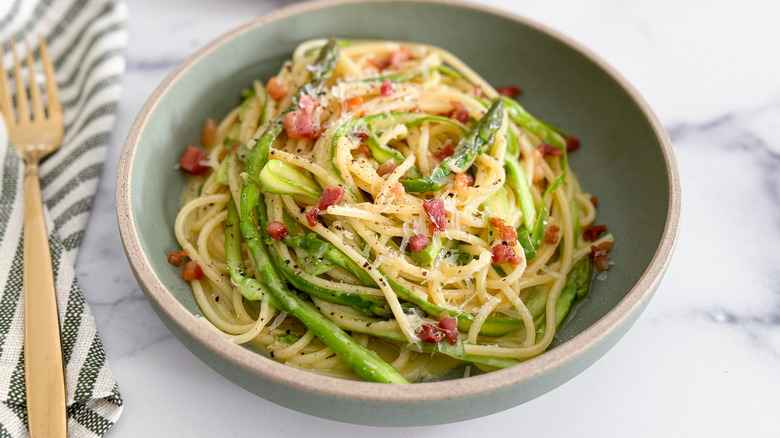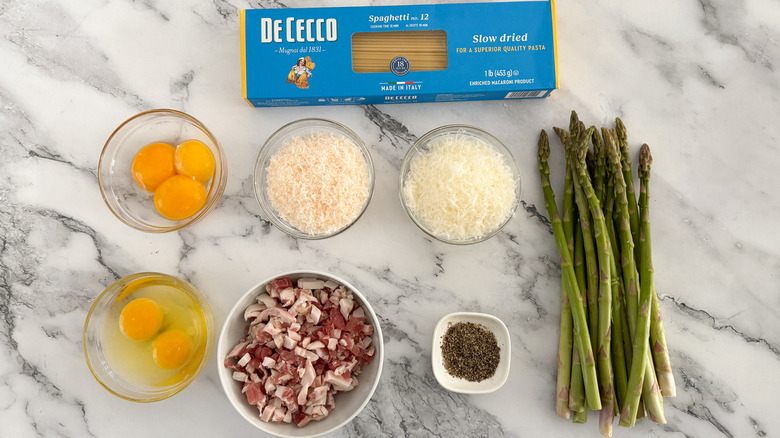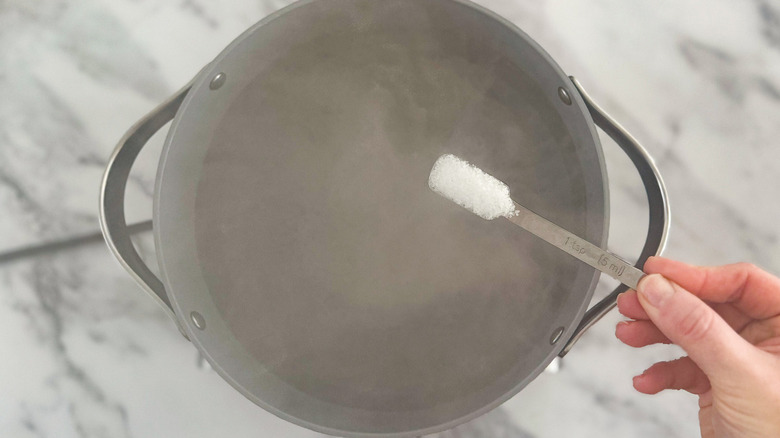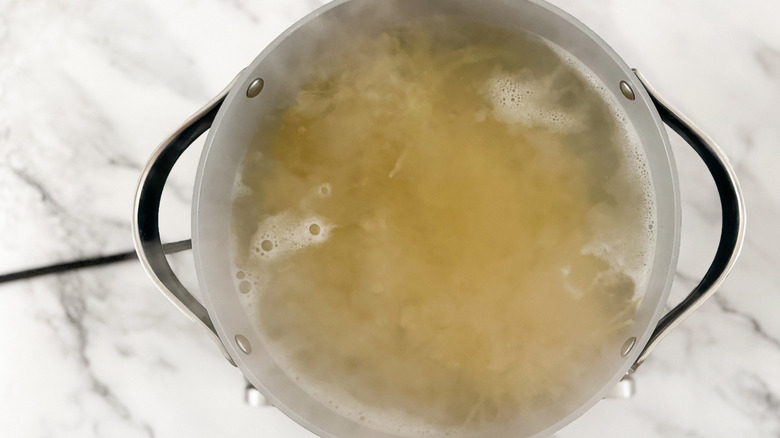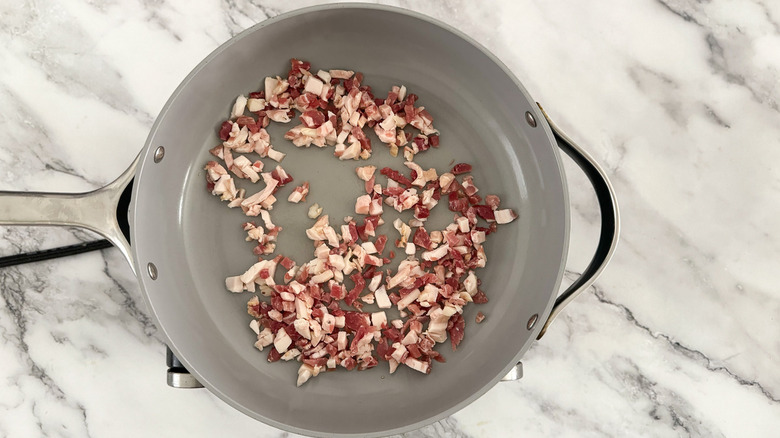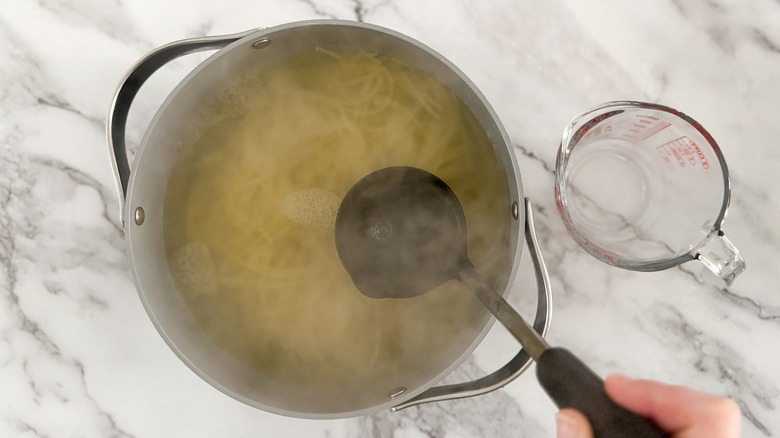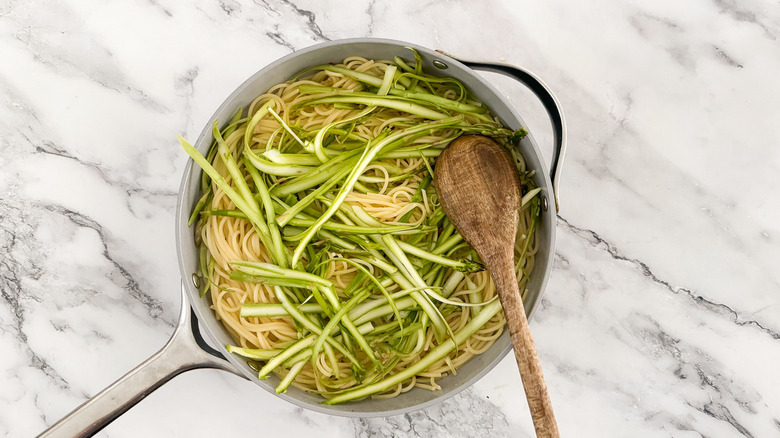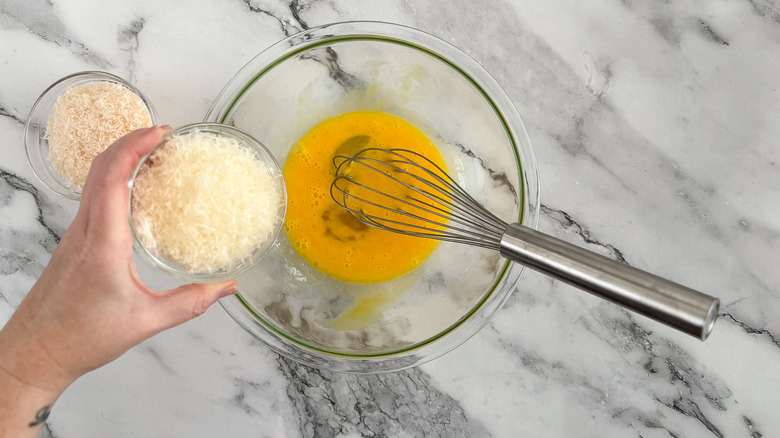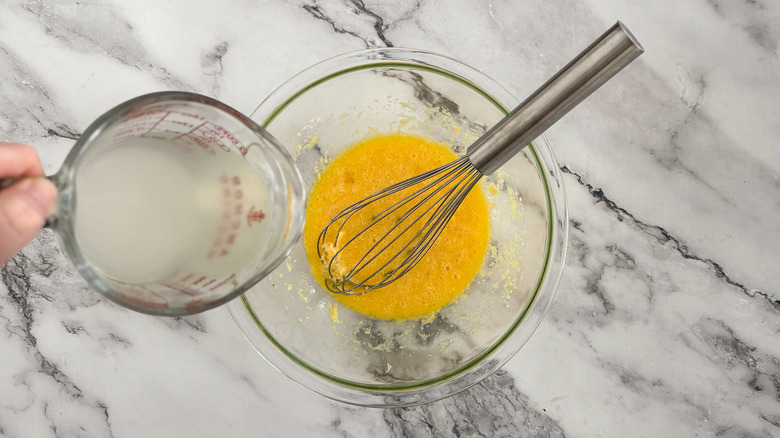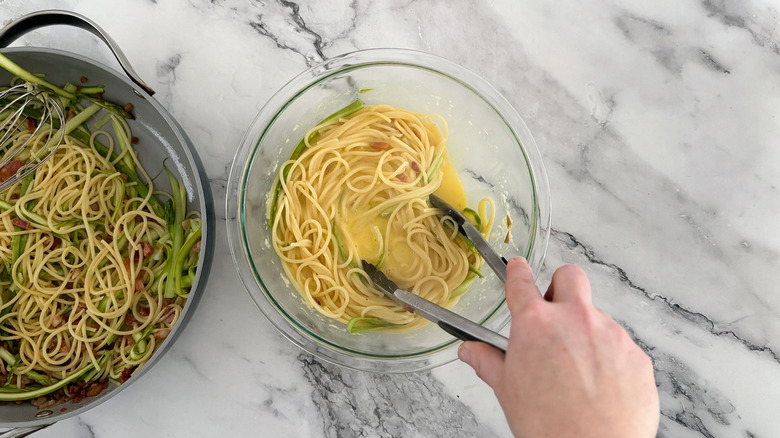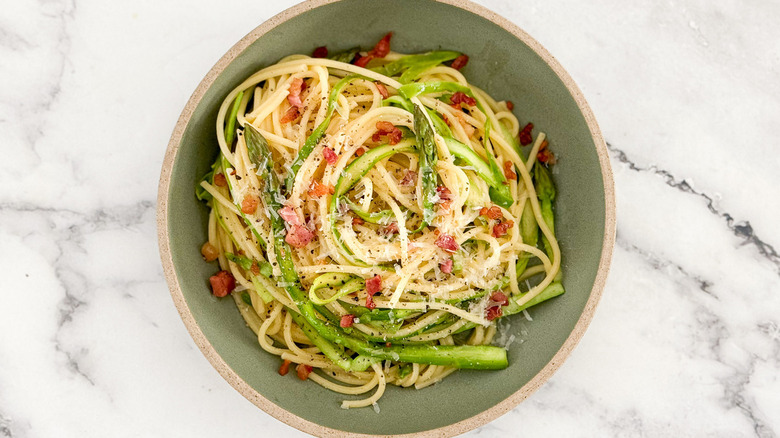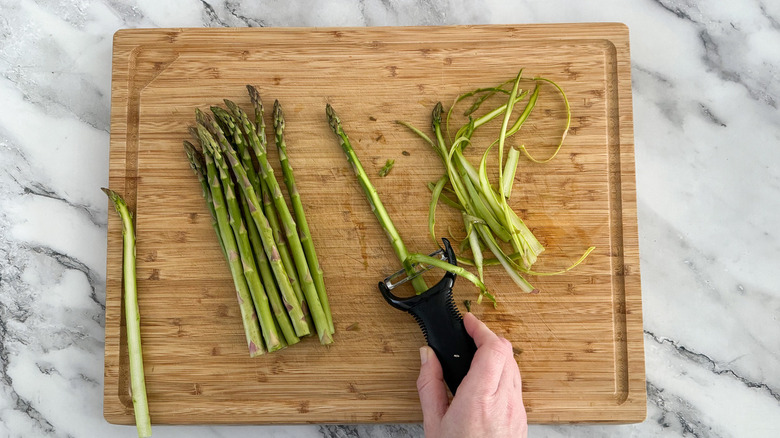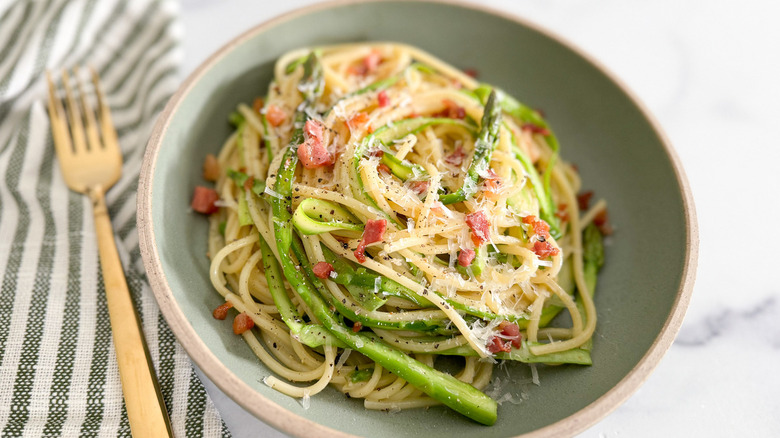Springy Asparagus Carbonara Recipe
While the phrase "springy asparagus" may have you envisioning veggies bouncing out of a pan, the asparagus in this dish is only lively in flavor rather than movement. Here, recipe developer Erin Johnson uses springy in the vernal sense of the word, telling us, "Asparagus makes carbonara feel lighter and perfect for spring." Plus, spring marks the start of asparagus season, when fresh-picked stalks start appearing from farmers' markets to grocery stores.
"Carbonara feels like a comfort food to me, and, as such, I like to showcase it," says Johnson, explaining that she makes a main-event meal of this savory, creamy pasta with nothing more than a simple green salad as an accompaniment. Though you're likely to finish off this recipe in one evening, Johnson has a trick for making next-day carbonara leftovers taste as fresh as possible: Save some pasta cooking water and use it to reheat the pasta on the stove until warm and glossy.
Collect the ingredients for springy asparagus carbonara
You'll need spaghetti, pancetta, asparagus, and eggs (both whole ones and yolks) for this pasta dish. To create the sauce, you'll use Parmesan and pecorino Romano cheeses and black pepper, while you'll also need some salt for cooking the spaghetti.
Step 1: Boil a pot of salted water
Bring a large pot of water to boil and add the salt.
Step 2: Cook the pasta
Add spaghetti to the boiling water and cook until al dente, according to package directions.
Step 3: Fry the pancetta
Meanwhile, add pancetta to a deep skillet and cook until the fat has rendered and the meat is crisp, about 4 minutes. Reduce heat to low.
Step 4: Save some pasta water and drain the spaghetti
Once the spaghetti is cooked, reserve 1 cup of the pasta cooking water before draining the spaghetti.
Step 5: Combine the asparagus, pancetta, and spaghetti
Add spaghetti and asparagus ribbons to the skillet with the pancetta and toss to combine.
Step 6: Beat the eggs with the cheeses
In a large bowl, beat together the eggs, egg yolks, Parmesan, and pecorino until smooth.
Step 7: Stir some pasta water into the egg mixture
Slowly and gradually add ½ cup of the reserved pasta water, whisking constantly. Set aside the rest of the water.
Step 8: Mix the spaghetti with the egg sauce
Gradually add the spaghetti mixture to the bowl with the egg mixture, stirring vigorously with tongs, to coat the pasta in the sauce. If necessary, add reserved pasta water 1 tablespoon at a time to thin the sauce to a cream-like consistency.
Step 9: Add pepper, and serve right away
Plate pasta and top with freshly cracked black pepper to taste. Garnish with additional Parmesan, if desired, and serve immediately.
How do you slice asparagus into ribbons?
To make the asparagus ribbons called for in this recipe, you'll first need to trim or snap off the hard, fibrous bits from the bottom of each stalk. Once this is done, use a vegetable peeler to shave the stalk down until you have nothing left but a pile of ribbons (and perhaps some broken-off tips, which are OK to leave in). While Johnson admits that it does take a little more work to prepare the asparagus this way, she says that the delicate ribbons "twirl perfectly with the spaghetti for the ultimate bite." Shaved asparagus, too, tends to be more tender than whole asparagus spears, making for a better texture in this pasta dish.
If you choose to substitute a different type of pasta, however, you may not need to ribbonize your asparagus after all. Johnson says that if you'll be going with a shorter, chunkier kind of pasta, such as rigatoni, chopping the asparagus into similarly-sized chunks may be a better bet. Since chunks won't cook as quickly as ribbons, you may want to add the asparagus to the boiling pasta in the last 2 minutes of cooking.
What's the difference between pancetta and guanciale?
If you were to make your carbonara in the most traditional way, the cured meat you'd use would be guanciale. Guanciale is sliced from a hog jowl and is known for being exceptionally fatty. It's also cured for months at a time, so it tends to have a rather strong flavor. The problem with this ingredient is that guanciale can be very expensive and, according to Johnson, somewhat difficult to find in the U.S. As a solution, she opts for a different pork product instead.
"Pancetta is my go-to for carbonara," Johnson explains, because it's fairly similar to guanciale despite being cut from pork belly and thus not quite so fatty. Pancetta is also cured for just weeks instead of months, so its flavor is slightly more subtle, and seasoned with juniper and sometimes sugar as opposed to the rosemary and sage typically found in guanciale. Both, however, have a porky, salty flavor and can generally be used interchangeably in cooking. If you can't find either one, though, Johnson says that diced bacon will serve the same purpose. Since each strip of standard-cut bacon weighs about an ounce, 5 strips should be sufficient for this recipe.
Springy Asparagus Carbonara Recipe
Shaved asparagus adds a pop of color and a fresh spring touch to classic, creamy carbonara. Better yet, this easy pasta dish is ready in 30 minutes or less.
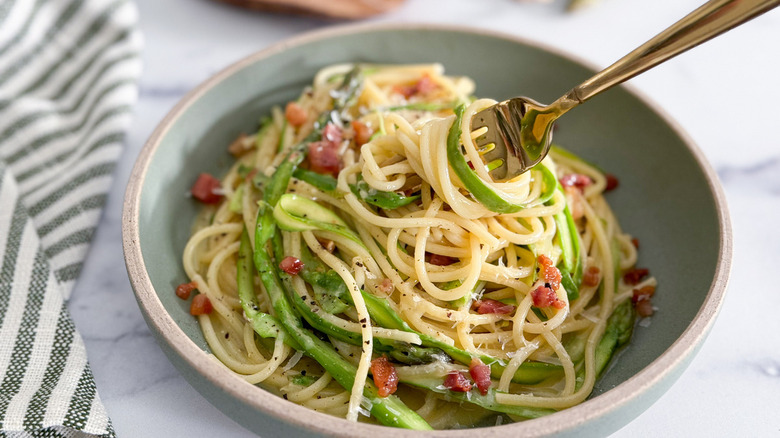
Ingredients
- 2 teaspoons kosher salt
- 2 ounces (¾ pound) spaghetti
- 5 ounces pancetta, chopped
- 10 stalks asparagus, sliced into thin ribbons
- 2 eggs + 3 egg yolks
- 2 ounces (about ⅔ cup) Parmesan, grated, plus more for serving
- 2 ounces (about ⅔ cup) pecorino Romano, grated
- Freshly cracked black pepper, to taste
Directions
- Bring a large pot of water to boil and add the salt.
- Add spaghetti to the boiling water and cook until al dente, according to package directions.
- Meanwhile, add pancetta to a deep skillet and cook until the fat has rendered and the meat is crisp, about 4 minutes. Reduce heat to low.
- Once the spaghetti is cooked, reserve 1 cup of the pasta cooking water before draining the spaghetti.
- Add spaghetti and asparagus ribbons to the skillet with the pancetta and toss to combine.
- In a large bowl, beat together the eggs, egg yolks, Parmesan, and pecorino until smooth.
- Slowly and gradually add ½ cup of the reserved pasta water, whisking constantly. Set aside the rest of the water.
- Gradually add the spaghetti mixture to the bowl with the egg mixture, stirring vigorously with tongs, to coat the pasta in the sauce. If necessary, add reserved pasta water 1 tablespoon at a time to thin the sauce to a cream-like consistency.
- Plate pasta and top with freshly cracked black pepper to taste. Garnish with additional Parmesan, if desired, and serve immediately.
Nutrition
| Calories per Serving | 342 |
| Total Fat | 22.8 g |
| Saturated Fat | 9.7 g |
| Trans Fat | 0.1 g |
| Cholesterol | 127.7 mg |
| Total Carbohydrates | 13.5 g |
| Dietary Fiber | 1.4 g |
| Total Sugars | 1.5 g |
| Sodium | 668.4 mg |
| Protein | 19.9 g |
